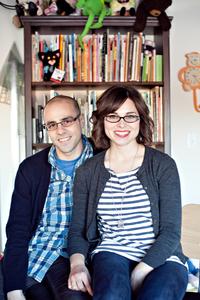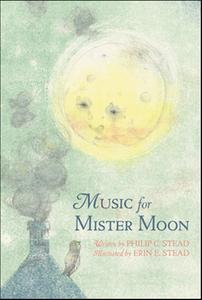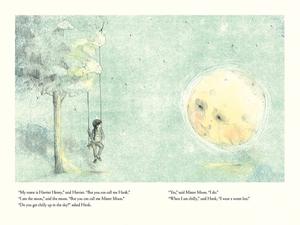
|
|
| Philip and Erin Stead (photo: Nicole Haley) |
|
Erin E. Stead is a Caldecott Medal-winning illustrator (A Sick Day for Amos McGee). She spoke with Shelf Awareness about her illustrative process, some of her favorite collaborations with her husband, author Philip Stead, and the importance of picture books. Their most recent book, Music for Mister Moon (Holiday House; reviewed below) is available now.
How many times have you collaborated with Philip? Are any of them a secret favorite or feel particularly special to you?
This book is our fifth collaboration, technically, although there are, gratefully, more in the works. This is a difficult question to answer, really. Amos McGee changed our life so much that it's the obvious winner. But it's as if that book is on its own plane. The very presence of that book in our life has exposed us to so much, teaches us to be better people and continues to surprise us with its reach.
So, Amos aside, the rest of the books all have their own space on the "special" shelf. For me, though, The Purloining of Prince Oleomargarine felt like our magnum opus. We threw our life into that book. No decision was made lightly and we were so supported by our editor and publisher that we could really run with the project (and turn in something about four times longer than they expected). My memories of that book are somewhat bittersweet, but I'm glad we were given the opportunity to make it.
Colliding directly with that book is actually Music for Mister Moon. I found out I was pregnant three-quarters of the way through the making of Oleomargarine and started Mister Moon about halfway through my pregnancy. Then, I threw out everything I had done right before the baby was born. Most of the book was finished with an infant strapped to my chest, so Moon will always be special to me.
 What is it like when the two of you are just starting on an idea? When do you bring it to outsiders?
What is it like when the two of you are just starting on an idea? When do you bring it to outsiders?
I don't want to speak for Philip as to how the manuscript came into being, although he does know that I have always wanted to play the cello. I actually don't know how to play any instrument, and Philip comes from a family of musicians so I'm a real black sheep. Normally, Phil gives me a warning that he's working on something and I've learned to do my best to leave him alone during the beginning phases of writing. Then he'll pass the manuscript onto me and I read it, with a pencil in hand to make line edits (saying that makes me cringe a little, as we are not just professional partners but married ones and perhaps I should be more loving upon my first pass...). There tends to be some passing back and forth for a bit between us before the manuscript goes off to our editor or agent. After that, I live with the writing for a while, trying to figure out how I'd like the book to feel before I start breaking the manuscript down to page turns and pacing.
You two have a baby now. Did that affect the writing and/or illustrating of the book?
We do! She's the best.
We had to push the book back a bit because I had to take some time to figure out how to care for an infant (I'll let you know when I get that nailed). This book came into being before the baby was born, so the only way she really affected this one is that I had to make it while she was bouncing around. I don't expect our stories to change much with her appearance. I think Phil and I make books for the kids we were because that's the only way we know how to make them honestly. I will say, though, that her presence has solidified how much I believe in books for children and how seriously I take the making of them.
 You created a website explaining your process for this book. On it you say that, because the book "resides in Harriet's dreams," you "wanted the art to be very atmospheric." So you printed all of the colors at the same time hoping to create "a seamless effect." Did this work?
You created a website explaining your process for this book. On it you say that, because the book "resides in Harriet's dreams," you "wanted the art to be very atmospheric." So you printed all of the colors at the same time hoping to create "a seamless effect." Did this work?
Oh, brother, I'm probably the worst person to answer this question. I hope so. But I hope all the art in all my books is seamless, too.
Printing the entire interior at once probably did fuel easier transitions from page to page. The book happens at night, but I also wanted it to feel as if there were smoke machines in it. Since I work traditionally (no digital alterations, everything you see in the book is the finished art on paper, warts and all, 99% of the time), I'm always up against what I am actually capable of making with my hands. That includes what skills I have and the skills I lack.
Is there anything else you'd like to tell Shelf readers?
Thanks for getting this far in the interview! One day I'll update that photo of us that's attached to this article. You should probably know, we look older. This interview might sound a little earnest. I ask you to grade me on a curve--I live in Michigan, it's March and I haven't seen the sun in four months.
Also, I believe in books and reading to kids more than ever, and even though there is a lot of science to back me up, I still often feel like those studies miss out on the human component of sharing a book with a kid. Thanks, Shelf Awareness readers, for supporting that, too.
--Siân Gaetano, children's and YA editor, Shelf Awareness

